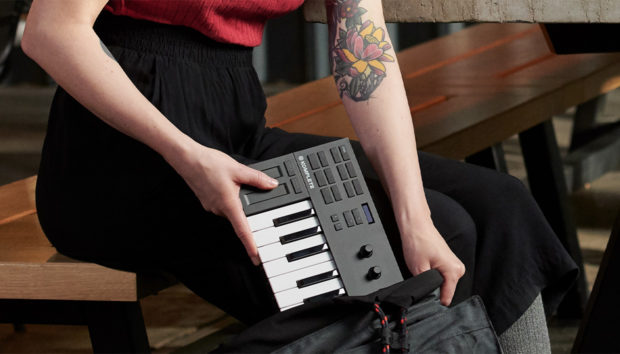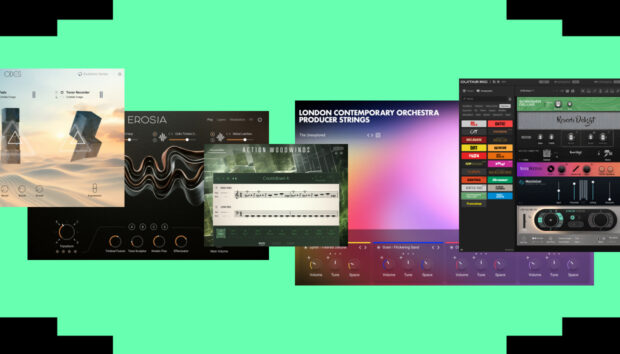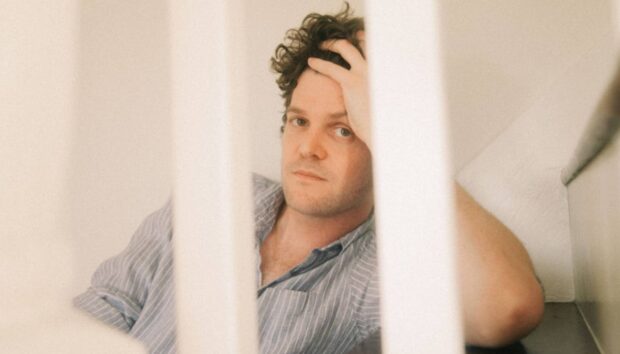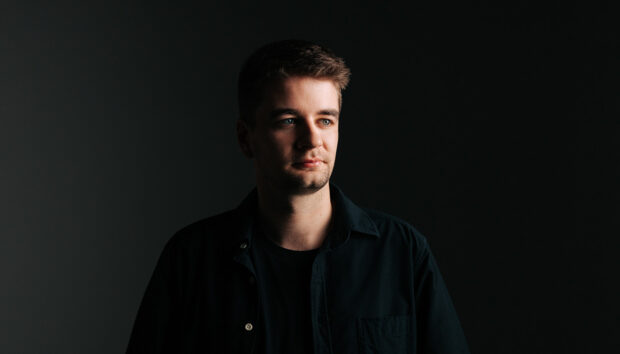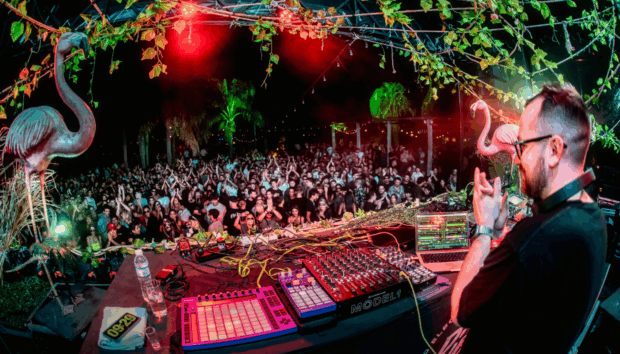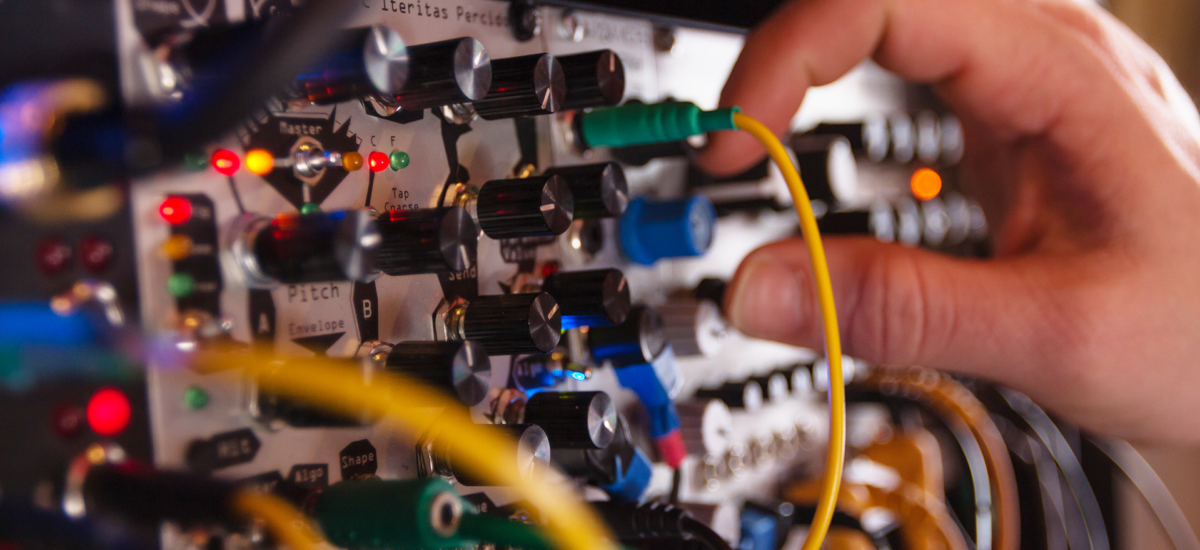
Where do you go after techno? Belief Defect point to sonic possibilities steeped in grimy, distorted industrial muck, drawing on techno’s rhythmic urgency and sounds, but finding new forms around them. Following the release of their epic LP ‘Decadent yet Depraved’ on Raster – the new label spun-off from Berlin’s Raster Noton – the outfit offers Native Instruments an intimate look at some of the processes behind their forward-thinking sound.
‘Decadent yet Depraved’ is an atmospheric offering, with esoteric, rich sound design and heady, dark overtones. An album on sombre, post-techno motifs, pieced together by an act with an abundance of production history. The identity of the two producers behind the Belief Defect moniker is loosely guarded. In order to keep the focus on the music, Native Instruments is under strict instruction not to say who they are. But thankfully, while the duo themselves remain mysterious, they’re more than willing to share some of their studio secrets.
They’ve melded analog outboard modular gear with a rig built around MASCHINE and REAKTOR. This setup turned REAKTOR into both a playground for achieving whatever sounds they desire, and a hub for controlling the resulting mayhem. MASCHINE provides tactile control for the REAKTOR ensemble’s inner workings, and acts as a MIDI sequencing hub.
Here’s some insight into the duo’s inspiration, and how they realized their ideas in the studio and live.
How did you wind up setting out on this project together?
YY: I don’t know how we started, but we kept talking about doing something that’s non-techno – something that doesn’t have resolve, tension, breakdown… whatever.
XX: We’re not sitting at home listening to techno records all the time. You go out and you play those records in the clubs, and when you come home you just dive into so much album-formatted music.
You spoke about listening to records as a starting point. What were you listening to?
XX: I brought Andy Stott… smaller, noisy, lo-fi industrial bands. Fuck Buttons, stuff like that, Haxan Cloak…
YY: The Andy Stott album, I was blown away in every aspect.
XX: I was getting kind of jaded writing techno dance tracks, because it’s so formulated and it’s kind of like coloring in between the lines – which can be fun sometimes. We both come from diverse backgrounds in music, and I just wanted to stop feeling like I was having to cater to people or deliver tracks that would, like, rock a dancefloor. Let’s just sit in the studio and make weird stuff and enjoy the experience of writing music, instead of feeling like it’s a job you’ve gotta deliver by a deadline.
YY: That was kind of the overall feeling – of being excited about music, like years ago.
It feels like there’s a clear sound world woven through the whole album. There’s that distorted kick, as a personality on each track, and then these delays.
XX: There’s a very cohesive sound to the album because of the instrumentation that we used. It started off with the development of a particular Reaktor ensemble.
YY: By now it’s just a pastiche of little ensembles.
XX: It’s like a Frankenstein of different ensembles, where we opened up the structure and pulled out things we liked and just kind of mashed it together.
YY: It must be more than ten years old, the original drum source.
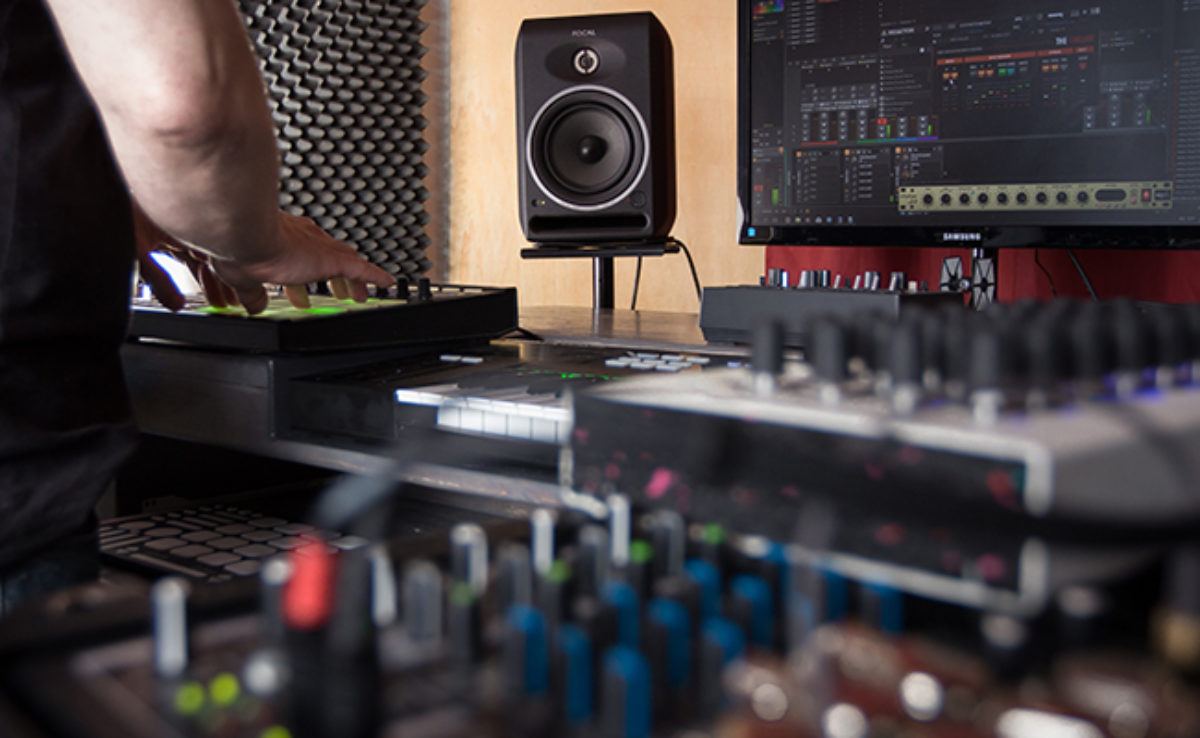
Do you want to say what those sources were?
XX: There’s so many…
YY: One of the one-knob compressors that they just came up with recently – that was one example. Change this, and then duplicate that, and then it all just grew to fit the way we were working.
XX: There were many versions of this particular ensemble… here’s a new version, here’s a new version, here’s a new version.
YY: We got to the point where we said, this is the last version. [laughs]
So then this thing you patched together became your instrument.
XX: The Reaktor ensemble is the heartbeat of the entire album. It’s dynamic enough to make a wide range of sounds to create an album, but still cohesive enough that it feels like it all came from the same place.
YY: When you have that one keyboard, one effect, you learn how to use them inside out. You focus.
XX: People figure out their own way of utilizing this particular instrument. We’ve shared this among our inner circle, and it’s become kind of a mainstay, but everybody’s been able to pump out completely different ways of handling it.
YY: The idea of using it was this vague notion that it delivered, like, deep kicks. And that kind of solved a lot for techno.
Everybody has the problem at some point of how to make the bass and the kick drum work with each other. If you can tune and stretch the kick drum, it kind of just solves that problem.
XX: It’s got an incredible way of distorting and compressing sound, and creating sidechains of its own, which creates different grooves in tracks. It’s kind of inspiring – you come up with something that you just would never have thought of otherwise.
There were elements pulled in for the record from multiple different sources, for different instruments, but when it came to rhythm section, drums, bass, low end… the beefiest part of it was all from the same Reaktor ensemble.

What does the rest of your instrumentation look like?
XX: There are various things for different tracks. Kontakt was a very big one, as well.
YY: Also Molekular. I didn’t know you could do that to voice. Vocals have always been a personal fixation, ever since Skinny Puppy. Using the harmonic quantizer, and then going crazy and have everything not drift into gibberish was just amazing.
XX: Believe it or not, a large majority of the stuff was Native Instruments plug-ins in general – just things from Komplete.
XX: I’d be bold enough to say 60% of the record was Reaktor. For sure. And there’s a handful of tracks where we pulled stuff off modular synths, just running patches and recording stuff.

I was going to ask what the other 40% was.
YY: It was whatever was happening at the moment.
XX: [interjects] Ah, here’s this. Take the 303, let’s record that. Whatever – it was just kind of plug and play, make cool stuff happen.
It’s interesting, this organic process you describe of copy / paste with the Reaktor patches – and then working with hardware and adding those elements. How do you contrast those two approaches?
YY: I think it’s a lot about adapting things to your system. [XX] had been pushing the whole Eurorack thing on me. Then Reaktor 6 happened, which allowed this kind of seamless integration [with the modular].
XX: Yeah, using Reaktor Blocks, basically. Even with the current modular outboard modular gear, also implementing it with Reaktor Blocks, sending CV through the sound card.
In the last few years I’ve personally developed a fond relationship with hardware instruments. I’ve never been a purist as far as only using hardware instruments or only software stuff. I’ve always felt inspired by whatever creates really cool stuff. I think Reaktor kind of caters to that nerdy side of me. Opening up that structure and seeing this web of wires is just as fucking cool to me as looking at a modular synth with a bunch of dangling patch cables.

YY: Whatever interface, whatever you connect to, is the way to go. What’s more practical and functional. Less thinking to get a result.
XX: We work differently, but I can speak for myself. I try to get the most out of something. I go to my studio, grab the Music Easel, take that out of the room, and just sit down and isolate myself with it. I’m just making music with this, just trying to push that thing as much as possible to get as many different ideas as possible out of it. Even this small Eurorack system that we have here. It’s not the most complex synthesizer – it’s got an oscillator and an envelope and a filter – it’s basically the structure of any other synthesizer. But I know how those modules work well enough to get the results I want from it.
YY: It’s about adapting stuff to your mindframe. Even performing, if you can figure out what structure works for you, then it’s easier to improvise.
When it’s the two of you together, how do you work? A tangle of hands, or is it divided up neatly?
XX: We both have strengths in different places.
YY: We were like, do this – don’t do THIS! [laughs]
XX: I would just come in and come up with some rhythmic or melodic idea, or just hit the keyboard and play notes and figure out a loop somewhere, and he would come in and massage it. And even if I dozed on the bed, by the time I woke up it morphed into something that I never would have thought of. So it was a pretty even exchange back and forth.
YY: I hadn’t worked with somebody for ten years or something. It’s not the easiest thing to surrender whatever you think it should be to the other person’s opinion. In terms of content, there was never a struggle – maybe we’d disagree on the right approach, but there was never any, “Aw, this is shit,” or, “No, this isn’t good.”
I saw you two play live at Berlin Atonal festival – how did you translate the album material onstage?
YY: I used the same kind of setup that I have for techno, which is computer, a few modules, and Bitwig in this case.
XX: We had two laptops and Bitwig has multiple stems from the album lined up. And he’s got a small modular Eurorack system that’s basically more for improv stuff – just sending sequences to it.
And then on my side, we have a laptop running Maschine in standalone mode. And I have the Reaktor ensemble that we were using on the album loaded up as a plug-in inside of it. I use Maschine to improv live drums, having it run a loop and tapping out the rhythms. It’s quantized, so all the beats fall into place.
YY: Techno is techno. But I can tell who’s playing and how he’s interacting with the drums.
XX: It’s a lot of drumming, basically, on my end of things. I have a Nord Drum 3 with the six pads. So there’s a segment in the track where I actually will play live drums on top of it. And also inside of Maschine, I’ve got MIDI out in one of the groups for sequencing the Nord Drum. It’s got all the synth parameters [as MIDI CC]. So the Maschine is kind of a master controller – I can control all the sounds coming off of Reaktor, and also sequence sounds off the Nord Drum.
YY: And that [Maschine] update – the CC out – it solved all this.
XX: The other cool thing about Maschine is that it became the perfect hardware counterpart to the Reaktor ensemble we used on the album. It became a tactile interface to play it with. Instead of drawing MIDI notes and turning knobs with the mouse, now we have a hardware controller that interfaces with [the Reaktor ensemble] perfectly. All the parameters from pitch to delay, feedback, and decay – everything is set up there. You can sequence it, using the note repeat to hit random high hat patterns etc.
And also that provides a different result than doing it by hand. Even inside of Maschine, you have scenes, just like you would in Ableton, with all the different drums and the Reaktor ensemble, and you can just switch the presets to different drum kits. It ends up becoming a pretty cool, dynamic tool to use live.
YY: By the end, when we were rehearsing, and we finally got the thing down, and we started to goof – then we actually started improvising with the thing, just randomly. And it’s an instant result for the whole sound.
You want to see the patch thing?
Yeah, let’s look at it.
The little waveform – that’s stolen from Polyplex.
XX: You basically have nine drum sounds. And each one of the drum sounds can be manipulated, stretched and pitched, warped, filtered.
YY: And this last thing is kind of a tempo-synced LFO. It just modulates the volume.
XX: All the drum cells end up going through a master chain. And all the effects, the reverb, the delay module that are inside of there, are sequenced.
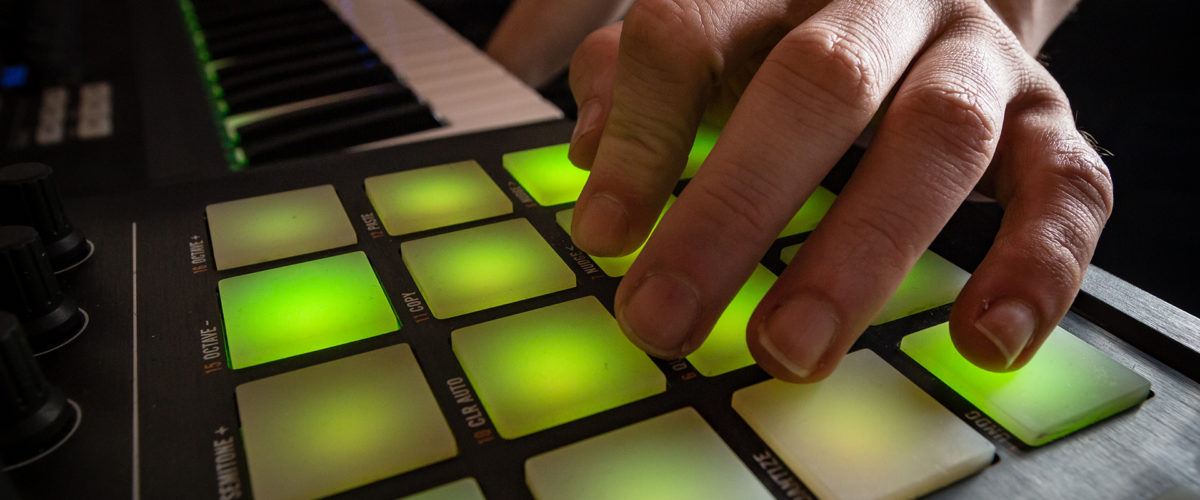
For the Atonal show, I basically just used a computer, Maschine, and the Nord drum. I had a delay pedal on the sound effects – the Strymon Big Sky.
As far as scenes go, I have them color-coded, for progression [through the set list]. It’s easy just to have a starting point.
And you assign macro controls in Maschine to Reaktor?
Mostly for the feedback, delay, and some of the pitch stuff. You can pick different kick drums.
YY: The distortion is key in the whole thing.
XX: Then there’s the Nord Drum [Maschine group], which is coded red since it’s red – with six CC parameters [for MIDI out].
Thanks, XX and YY!
The artists aso gave us a closer look at those Reaktor patches and the Maschine setup:
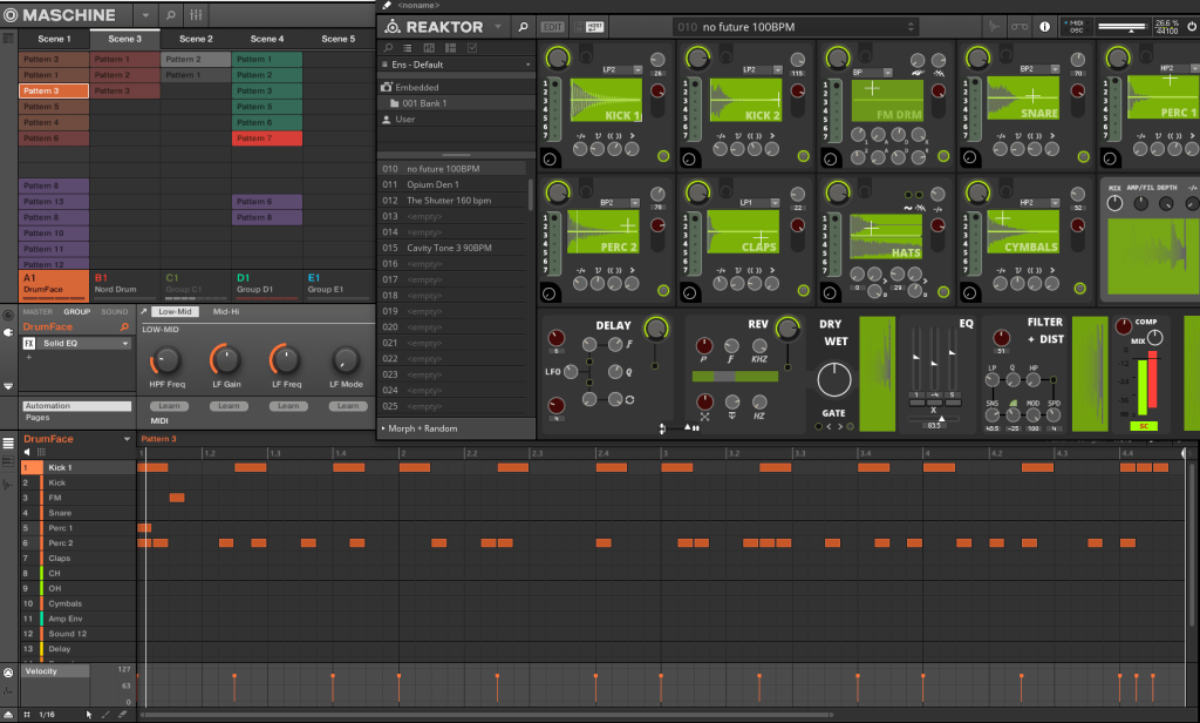
The “Frankenstein” Reaktor patch. Kicks and drum parts each get their own module, and warping controls for each waveform. But the key to the sound is the bottom right – EQ, filter, compressor, sidechaining, and that signature distortion.
Behind it, you’ve got the Maschine scenes and patterns. Bottom, you can see a pattern for sequencing the external Nord Drum (via Maschine’s MIDI CC out and a dedicated group).
For different tracks, there are different Reaktor snapshots for the master ensemble – but the same Reaktor patch always stays in the same Maschine group.
photo credits: Giovanni Dominice
further articles by Peter Kirn can be read at Create Digital Music.









